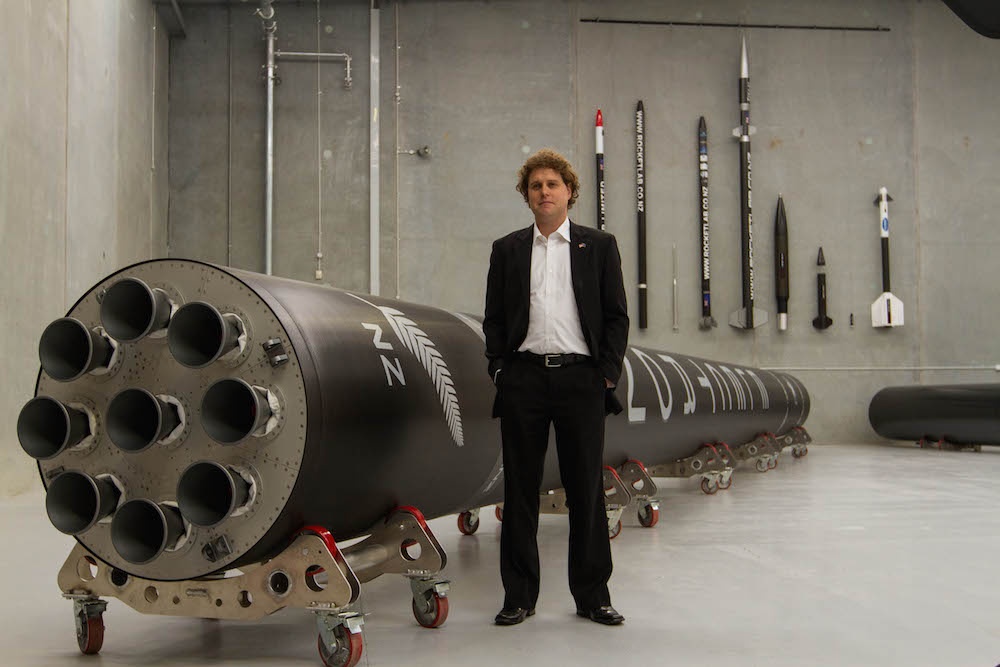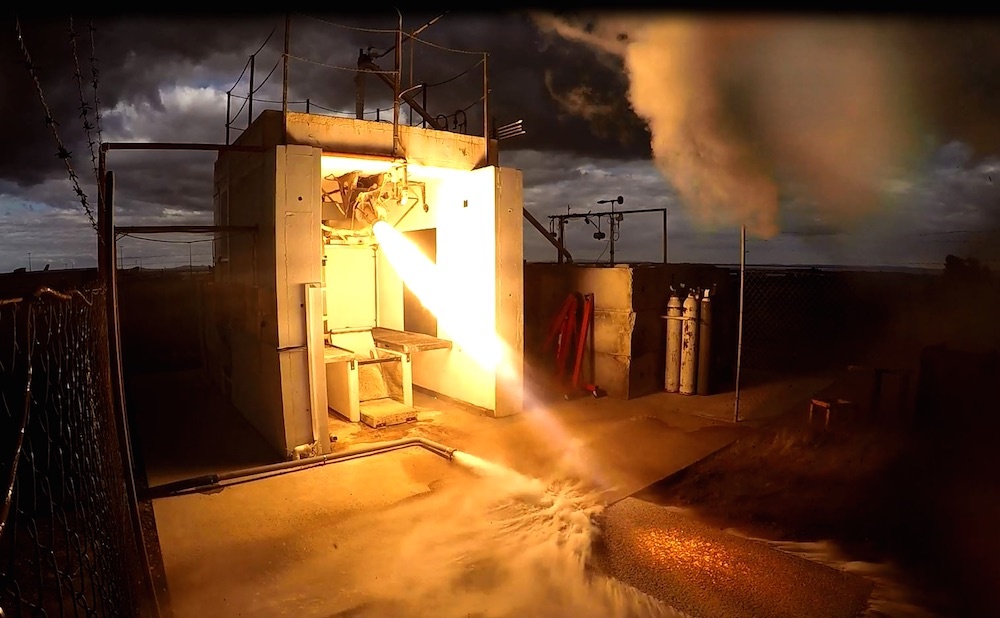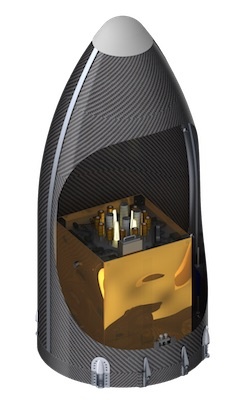By Mark Mackay and Iain Finer
Peter Beck, CEO of Rocket Lab stands with an early test article of the Electron rocket
Electric Rutherford Engine
According to their press release:
“Unlike traditional propulsion cycles based on complex and expensive gas generators, the 4,600 lbf Rutherford adopts an entirely new electric propulsion cycle, making use of high-performance brushless DC electric motors and lithium polymer batteries to drive its turbopumps.”
So how does switching to electric turbopumps help?
Firstly, this must be far simpler to manage than all the additional plumbing, control systems, and moving parts that come with traditional systems. Switching to an electric motor that turns on with the flick of a switch seems like a no-brainer. And with nine engines in its tail, this will substantially simplify the intricate web of cables and hoses.
Electric pumps should also provide a great deal of control over how the propellant is injected into the engine. Electron utilises liquid oxygen and rocket-grade kerosene as propellants, and like most engines - the mixture needs to be delicately controlled to match various power levels. We would imagine that it is possible to shut down and then restart the engine mid-flight. Electric pumps may also provide improved dynamic control over fuel flow rates, allowing for fine-grained tuning of the mixture and even greater efficiency and throttle-range.
| Rocket Lab's new Rutherford engine, powered by two electric turbopumps (one visible, in red). Pneumatic actuators (blue) allow the engine to be steered. | Compared with SpaceX's Merlin 1c engine - Rocket lab doesn't need the turbine exhaust and should require far less plumbing. (Note: the two engines are vastly different sizes in real life)
|
A big question is whether the electric turbopump will save weight. Batteries are heavy, but the turbopump itself would likely be lighter than its gas-fed equivalent, and all of the rocket’s propellant would be used to get the vehicle to orbit (not spin pumps). We need some more specifications from Rocket Lab to answer this question, but we’d gamble that it's more efficient, or the simplicity trade-off was worth it.
Moving away from gas-turbines was also likely driven by size constraints. SpaceX’s Falcon 9 rocket is 3.66m in diameter, whereas Electron is only 1m. This makes the engine no larger than the average kitchen rubbish bin.
What’s in a name?
The announcement also puts greater heritage in Rocket Lab’s choice of nomenclature for their rocket systems. Founder Peter Beck has previously announced that the engines were named after New Zealand scientist Ernest Rutherford. The choice to name the vehicle “Electron” was perhaps dismissively thought to relate to the scientist’s nuclear physics work, but may be more to do with the battery-powered rockets within.
Printing your own Rocket Engine
Rocket Lab is following a similar approach to most newspace companies and is adopting 3D printing for as many systems as possible:
“Rutherford is the first oxygen/hydrocarbon engine to use 3D printing for all primary components including its engine chamber, injector, pumps and main propellant valves. Using this process, Rocket Lab’s engineers have created complex, yet lightweight, structures previously unattainable through traditional techniques, reducing the build time from months to days and increasing affordability.”
3D-printed rocket components and engines have been successfully tested but if Rocket Lab achieves their target to launch by the end of 2015, they may be the first to achieve orbit using one.
Payload Integration
One of the more “why didn’t I think of that” announcements for both authors related to how they plan to get the satellites loaded into the rockets:
“Electron’s upper stage is designed with the capability to disconnect the payload integration from the main booster assembly. Sealed integrated payloads can then be transported back to Rocket Lab where integration with the main booster can occur in a matter of hours. This approach eliminates the risk of cascading delays and allows customers to regain control of the integration process, using their own preferred facilities and personnel.”
It’s important to remember that Rocket Lab are targeting weekly launches of Electron. Traditionally the launch vehicle operator take a large role in integrating their customer’s satellite into their vehicle. If there are problems, this can be very time-consuming and costly for both parties to resolve. And if you’re trying to manage 52 satellites each year, that’s a lot of logistics to coordinate.
Rocket Lab elegantly solves this by making launch integration the customer’s responsibility. They simply ship (sell?) them the top of the rocket, let them spend as much time as they want getting their satellite to fit and plug in correctly to the module - and then they ship it back to Rocket Lab to launch. When it arrives, it’s given a quick check-out, placed on top, you attach four bolts, connect a few umbilical cables and drive it out to the launch pad. Of course we’re overstating the simplicity, but clearly moving the complicated phase off-site will save Rocket Lab a lot of headache.
And there are other potential benefits too. What do you do if you’re launching each week, and your customer hasn’t dropped their satellite off yet? Simply grab the next integrated satellite from your holding area and launch them instead! Or what if you notice a problem with your rocket while you’re running your pre-flight checks on the launch pad? You simply swap out the rocket base with another one, and continue your countdown.
There are some interesting questions from a legal standpoint. If you’ve made the satellite operator do their own payload integration, and you’ve launched and delivered the rocket to the right orbit -- then presumably it’s their fault if something is wrong with the satellite. But what if the payload fairing fails to separate? The customer integrated the upper module, but it was Rocket Lab’s hardware…
Another interesting angle is sensitive payloads and dealing with countries/organisations that don’t meet normal security requirements for dealing with rocket hardware. Potentially the US government for example could ship Rocket Lab a sealed upper-stage, with “do not open” instructions. And customers without security clearance can still hand-over their integrated satellite at the door to the building, and just not be allowed to see inside.
--
Overall, today’s announcements by Rocket Lab are very exciting and bode well for them delivering on their planned price-point and rapid launch schedule. All this innovation needs to be flight-tested of course, but in many ways their changes simplify the rocket and reduce risks.
We hope there are more tidbits revealed at the NSS conference this week. And in the coming months we should learn where in New Zealand they’ll be launching from -- and most importantly, when that magical first launch attempt will be.
| Electron Fast Facts |
|---|
|




